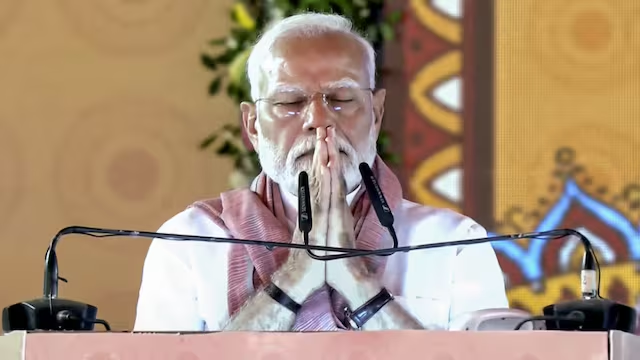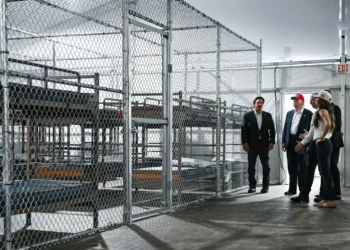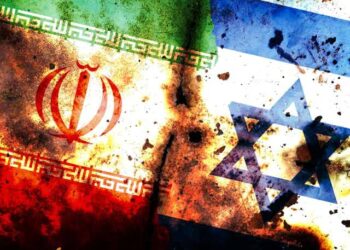Prime Minister Narendra Modi confirmed that Indian forces carried out cross-border strikes on terror camps in Pakistan after the April 22 Pahalgam attack.
In a recent address, Modi emphasized that the country’s response through Operation Sindoor was a powerful demonstration of its strength and resolve against terrorism.

The India-Pakistan conflict has been marked by serious incidents, with the Pahalgam terror attack being a significant escalation.
Key Takeaways
- Indian forces conducted cross-border strikes after the Pahalgam attack.
- Operation Sindoor was a significant response to terrorism.
- The conflict between India and Pakistan remains a serious issue.
- Prime Minister Narendra Modi emphasized a zero-tolerance policy.
- The ceasefire following Operation Sindoor has been a critical development.


The Pahalgam Terror Attack: Catalyst for India’s Response
The April 22 Pahalgam terror attack was a barbaric act that catalyzed India’s resolve against terrorism. Prime Minister Modi described it as “the most barbaric face of terrorism”, highlighting the severity and brutality of the attack.
On April 22, terrorists struck in Pahalgam, a popular tourist destination in Jammu and Kashmir, resulting in significant civilian casualties. The attack was caught on CCTV footage, which later became crucial evidence in assessing the attack’s details.
Timeline of the April 22 Attack on Tourists
The attack occurred in the late afternoon, around 5:30 PM, when tourists were returning from a visit to the nearby Betalab Valley. Terrorists ambushed the group, firing indiscriminately.
The assault lasted several minutes, with eyewitnesses describing the scene as chaotic and terrifying. The terrorists escaped into the nearby woods, leaving behind a trail of destruction.
Civilian Casualties and Eyewitness Accounts
The attack resulted in significant civilian casualties, with multiple tourists injured and killed. Eyewitness accounts described the terrorists as heavily armed and wearing traditional clothing.
“It was like a nightmare come true. We were just returning from a trip when suddenly there were gunshots everywhere,” said one survivor.
Initial Security Assessment and Evidence of Pakistani Involvement
Initial investigations and security assessments pointed towards Pakistani involvement in the Pahalgam terror attack. Evidence collected from the site, including CCTV footage and eyewitness testimonies, indicated a well-planned operation.
The Indian government swiftly condemned the attack, vowing to take decisive action against those responsible.
PM Modi Operation Sindoor Speech: India Pakistan Conflict Latest Updates
In a bold address to the nation, PM Modi highlighted the success of Operation Sindoor, a strategic strike against terrorism. This operation marked a significant escalation in India’s response to the growing threat of terrorism emanating from across the border.

Key Highlights from Modi’s Address to the Nation
Prime Minister Narendra Modi’s speech was a comprehensive overview of India’s stance on terrorism and the measures taken to counter it. The key highlights included:
- Confirmation of Cross-Border Strikes: PM Modi confirmed that India had conducted cross-border strikes as part of Operation Sindoor.
- Tribute to Armed Forces: The Prime Minister paid a heartfelt tribute to the armed forces, scientists, and intelligence services for their role in the operation.
- Message to Pakistan: Modi’s speech was seen as a strong message to Pakistan, emphasizing India’s zero-tolerance policy towards terrorism.
“India’s Response Shook Pakistan” Statement Analysis
The statement “India’s response shook Pakistan” was a significant assertion made by PM Modi during his address. This statement underscored the impact of Operation Sindoor on Pakistan, suggesting that the operation had a profound effect on the country’s perception of India’s resolve against terrorism.
Modi’s Tribute to Armed Forces, Scientists, and Intelligence Services
PM Modi’s tribute to the armed forces, scientists, and intelligence services highlighted the strategic planning and operational excellence that went into Operation Sindoor.
Recognition of Strategic Planning
The Prime Minister recognized the meticulous planning that preceded the operation, emphasizing the role of intelligence services in identifying and targeting terrorist infrastructure.
Acknowledgment of Operational Excellence
Modi also acknowledged the operational excellence displayed by the armed forces during the execution of Operation Sindoor, highlighting their professionalism and bravery.
By confirming the cross-border strikes and praising the armed forces, PM Modi’s speech reinforced India’s commitment to countering terrorism. The operation and the subsequent speech have significant implications for India-Pakistan relations and the broader regional security landscape.
Inside Operation Sindoor: Anatomy of India’s Cross-Border Strike
Operation Sindoor was a landmark event in India’s military history, showcasing its capabilities against terrorism. This operation was a significant response to the Pahalgam terror attack, demonstrating India’s resolve to counter terrorism effectively.
Strategic Planning and Intelligence Gathering
The success of Operation Sindoor hinged on meticulous strategic planning and precise intelligence gathering. Indian intelligence agencies worked tirelessly to identify key terrorist hubs in Bahawalpur and Muridke. Satellite images played a crucial role in pinpointing these locations, enabling the Indian military to plan precision strikes.
Precision Strikes on Terror Hubs in Bahawalpur and Muridke
The operation involved precision strikes on terrorist facilities in Bahawalpur and Muridke, significantly damaging their operational capabilities. These strikes were executed with utmost care to minimize collateral damage, showcasing India’s ability to conduct surgical strikes.
Military Assets and Technology Deployed
The operation utilized a range of military assets and cutting-edge technology.
Air Force and Missile Systems Utilized
The Indian Air Force played a pivotal role, with its aircraft and missile systems being crucial in executing the strikes. The use of missile systems allowed for precise targeting of terrorist camps.
Special Forces and Covert Operations
Special forces were involved in covert operations, further enhancing the effectiveness of the operation. Their role was critical in ensuring that the terrorist infrastructure was thoroughly dismantled.
| Aspect | Details | Significance |
|---|---|---|
| Strategic Planning | Intelligence gathering, satellite imaging | Precise targeting of terrorist hubs |
| Precision Strikes | Air Force, missile systems | Effective damage to terrorist facilities |
| Military Assets | Special forces, air force | Enhanced operational effectiveness |
The operation Sindoor marked a significant shift in India’s counter-terrorism strategy, showcasing its willingness to take proactive measures against terrorism. By comparing it to previous operations like the Balakot airstrike, it becomes evident that Operation Sindoor was a more nuanced and sophisticated operation.
Modi’s Zero Tolerance Policy: Evolution of India’s Counter-Terrorism Strategy
With a firm commitment to combating terrorism, PM Modi has redefined India’s counter-terrorism strategy. This shift is evident in the government’s proactive approach to national security, marking a significant departure from traditional defensive measures.
Shift from Defensive to Preemptive Doctrine
India’s counter-terrorism strategy has transitioned from a defensive to a preemptive doctrine under PM Modi. This change is characterized by precision strikes against terror hubs, such as those in Bahawalpur and Muridke, demonstrating India’s capability to counter threats proactively.
| Aspect | Defensive Doctrine | Preemptive Doctrine |
|---|---|---|
| Approach | Reactive measures | Proactive strikes |
| Objective | Mitigate damage post-attack | Prevent attacks through deterrence |
| Example | Ceasefire agreements | Operation Sindoor |
Modi’s “New India” Approach to National Security
The “New India” initiative under PM Modi emphasizes a robust national security framework. This approach includes enhanced intelligence gathering and strategic military operations, ensuring a comprehensive response to terrorism.
Political and Public Support for Aggressive Response
The political and public backing for India’s aggressive response to terrorism has been significant. The government’s zero-tolerance policy has resonated with the public, fostering a united stance against terrorism.
Operation Sindoor and the destruction of Pakistan’s terror camps have been pivotal in this new strategy, showcasing India’s resolve to tackle terrorism head-on.
Pakistan’s Reaction: Diplomatic Scramble and Ceasefire Appeals
In the aftermath of Operation Sindoor, Pakistan intensified its diplomatic efforts, seeking support from the international community. The operation, a significant escalation by India, prompted a multifaceted response from Pakistan, including official statements, emergency security meetings, and outreach to global partners.

Official Statements from Pakistani Leadership
Pakistani leaders condemned Operation Sindoor, characterizing it as a severe violation of sovereignty. The Prime Minister of Pakistan issued a statement urging the international community to intervene, emphasizing that India’s actions could lead to a significant conflict in the region. Pakistan’s Foreign Office released a detailed report accusing India of “nakedly violating” international law and the Shimla Agreement.
Emergency Security Meetings and Military Alerts
Following Operation Sindoor, Pakistan convened emergency security meetings to assess the situation and formulate a response. The National Security Committee (NSC) held an urgent meeting to discuss the implications of the operation. As a result, Pakistan’s military was put on high alert, with enhanced surveillance along the Line of Control (LoC) and the International Border (IB).
International Outreach and Damage Control Efforts
Pakistan actively engaged in diplomatic outreach to mitigate the fallout from Operation Sindoor. The country reached out to key allies and international organizations, seeking support and condemnation of India’s actions.
Appeals to United Nations
Pakistan formally appealed to the United Nations Security Council (UNSC), urging it to take immediate action to address the escalating tensions. The UNSC was presented with a detailed dossier outlining India’s alleged violations and the potential for further conflict.
Communication with Allied Nations
In addition to its appeal to the UN, Pakistan communicated with its allied nations, including China and Saudi Arabia, to garner support. These countries were informed about the situation, and Pakistan sought their assistance in de-escalating the conflict through diplomatic channels.
The diplomatic efforts by Pakistan highlighted the complexities of the India-Pakistan conflict, with both countries engaging in a war of words and diplomatic maneuvering. The international community’s response to the conflict will be crucial in determining the future trajectory of India-Pakistan relations.
Terror Infrastructure Targeted: Exposing Pakistan’s Terror Network
In a bold move, India targeted key terror infrastructure in Pakistan, revealing a complex terror network. Operation Sindoor was a significant counter-terrorism effort that aimed at dismantling terror camps in Bahawalpur and Muridke.
Bahawalpur Terror Camps: History and Operational Significance
The Bahawalpur terror camps have been a hub for terrorist activities for years. These camps were used for training terrorists and planning operations against India.
Operational Significance: The Bahawalpur camps were crucial for the operational planning and execution of terrorist attacks. They were equipped with state-of-the-art facilities and were overseen by high-ranking officials.
Muridke Facilities: Training Centers and Command Structures
Muridke facilities were another significant terror hub targeted during Operation Sindoor. These facilities were used for training terrorists and housing command structures.
| Facility | Function | Significance |
|---|---|---|
| Bahawalpur | Training and Planning | High |
| Muridke | Training and Command | High |
Intelligence Reports on Active Terror Cells and Their Leadership
Intelligence reports indicate that several active terror cells were operational in Pakistan, with leadership structures intact despite the operation.
Leadership: The leadership of these terror cells was found to be closely linked to high-ranking Pakistani officials, raising serious questions about their complicity.
Operation Sindoor vs. Previous Military Actions: Tactical Evolution
The Indian military’s Operation Sindoor represented a tactical evolution, showcasing advancements in precision and intelligence gathering. This operation built upon the foundations laid by previous military actions, including the 2016 surgical strikes and the 2019 Balakot airstrike.
2016 Surgical Strikes: Operational Differences
The 2016 surgical strikes were a significant departure from India’s traditional military response, focusing on precision targeting of terrorist camps across the Line of Control. Operation Sindoor, while continuing this trend, demonstrated enhanced intelligence capabilities and a more sophisticated approach to cross-border strikes.
2019 Balakot Airstrike: Strategic Advancements
The 2019 Balakot airstrike marked a strategic escalation, with India employing airpower to target a major terrorist training camp. Operation Sindoor further refined this approach, incorporating advanced technological and intelligence capabilities to achieve its objectives.
Technological and Intelligence Capabilities Enhancement
A key aspect of Operation Sindoor was its reliance on cutting-edge technology and enhanced intelligence gathering. This is evident in the operation’s precision and effectiveness, setting it apart from previous actions.
| Operation | Year | Key Characteristics |
|---|---|---|
| Surgical Strikes | 2016 | Precision targeting, cross-border operation |
| Balakot Airstrike | 2019 | Airpower deployment, targeting terrorist camps |
| Operation Sindoor | 2024 | Advanced technology, enhanced intelligence, strategic escalation |
Operation Sindoor signifies a new era in India’s counter-terrorism strategy, leveraging lessons from past military actions to achieve a more effective response.

Global Response to Operation Sindoor
As news of Operation Sindoor spread, countries around the world reacted with a combination of official statements and covert diplomatic maneuvers. The operation’s implications were far-reaching, prompting a multifaceted global response.
United States Position and Strategic Considerations
The United States took a cautious approach, weighing its strategic interests in the region against its counter-terrorism priorities. The US stance on Operation Sindoor was influenced by its longstanding relationship with India and its concerns about Pakistan’s role in harboring terrorist organizations.
United Nations Security Council Discussions
The United Nations Security Council (UNSC) held discussions on Operation Sindoor, with a focus on its implications for regional stability. The UNSC’s response was shaped by the diverse interests of its member states, resulting in a nuanced and carefully worded statement.
Reactions from China, Russia, and European Union
The reactions from China, Russia, and the European Union were varied, reflecting their respective geopolitical priorities.
Official Statements
China and Russia, both close allies of Pakistan, expressed concerns about the escalation of tensions in the region. The European Union, meanwhile, issued a statement calling for restraint and emphasizing the need for a peaceful resolution.
Behind-the-Scenes Diplomatic Engagements
Behind the scenes, diplomatic engagements were underway, with countries engaging in discreet discussions to de-escalate tensions. These efforts aimed to prevent further conflict and promote a return to diplomatic negotiations.
| Country/Entity | Official Statement | Behind-the-Scenes Efforts |
|---|---|---|
| United States | Cautious support for India’s actions | Diplomatic outreach to Pakistan |
| China | Concerned about escalation | Quiet diplomacy with India |
| Russia | Called for restraint | Engagement with both India and Pakistan |
| European Union | Advocated for peaceful resolution | Multilateral discussions with key stakeholders |
Human Stories: Victims of Pahalgam Attack and Heroes of Operation Sindoor
The resilience of those affected by the Pahalgam attack is a testament to their strength. The tragedy not only claimed lives but also left deep scars on the families and communities involved.
Profiles of Civilian Victims and Their Families
The Pahalgam attack resulted in the loss of innocent lives, leaving behind grieving families. The victims were primarily tourists who had traveled to the region for the Amarnath Yatra pilgrimage. The attack was widely condemned, and the nation mourned the loss.
Among the victims were individuals from various backgrounds, united by their faith and purpose. Their stories are a poignant reminder of the human cost of terrorism.

Recognition of Military Personnel Involved in the Operation
The Indian Armed Forces played a crucial role in Operation Sindoor, demonstrating exceptional bravery and strategic prowess. The operation was a significant response to the Pahalgam attack, showcasing India’s resolve against terrorism.
| Personnel Category | Role in Operation Sindoor | Recognition |
|---|---|---|
| Special Forces | Conducted precision strikes | Awards for Valor |
| Intelligence Units | Gathered critical intelligence | Commendations for Service |
| Logistical Support | Facilitated operational readiness | Certificates of Appreciation |
Impact on Communities in Border Regions
The repercussions of the Pahalgam attack and Operation Sindoor were felt deeply in the border regions. Communities experienced heightened security measures and an increased military presence.
While the operation was a significant military success, it also underscored the need for continued vigilance and cooperation between security forces and local communities to maintain peace and stability in Jammu and Kashmir.
India-Pakistan Ceasefire Reality: Patterns of Violation and Enforcement
The India-Pakistan ceasefire, a critical component of their fragile peace, has seen numerous challenges since its inception in 2003. This ceasefire along the Line of Control (LoC) and the International Border (IB) has been a significant development in the bilateral relations between the two nuclear-armed neighbors.
History of Ceasefire Agreements Since 2003
The ceasefire agreement in 2003 marked a crucial step towards reducing tensions between India and Pakistan. Initially, it led to a significant decrease in Line of Control violations. However, over the years, there have been numerous instances of ceasefire breaches, often resulting in casualties on both sides.
The agreement was seen as a confidence-building measure, aiming to create a conducive environment for peace talks. Despite this, militant infiltration and cross-border firing have continued to be contentious issues.
Statistical Analysis of Violations Over the Past Decade
Analyzing the past decade, there has been a fluctuating trend in ceasefire violations. Data indicates a rise in incidents during periods of heightened tensions, such as during the Pulwama crisis in 2019. Statistical analysis reveals that ceasefire violations have resulted in significant military and civilian casualties.
- Increase in ceasefire violations correlates with heightened tensions.
- Civilian casualties have been a major concern.
- Military responses to violations have varied, impacting the overall ceasefire.
Current Status of Line of Control and International Border
As of the latest reports, the situation along the LoC and IB remains volatile. There have been continued reports of line of control violations, with both sides accusing each other of initiating firing.
The India-Pakistan border latest news often highlights the fragile nature of the ceasefire, with incidents of shelling and firing being regularly reported. Efforts to maintain peace and adhere to the ceasefire agreement continue, with diplomatic channels remaining open.
Strategic Implications for South Asian Security Architecture
With Operation Sindoor, India has taken a bold step that is redefining the security paradigm in South Asia. This operation has significant strategic implications, affecting the delicate balance of power in the region.
Shifting Power Dynamics Between Nuclear-Armed Neighbors
The execution of Operation Sindoor has led to a notable shift in the power dynamics between India and Pakistan, both of which are nuclear-armed nations. As Prime Minister Modi emphasized, “India will not tolerate terrorism.” This stance has been reinforced through military actions that have targeted terrorist infrastructure in Pakistan.
The operation has demonstrated India’s capability to conduct precise and effective cross-border strikes, thereby altering the strategic calculus of Pakistan. As a result, Pakistan is likely to reassess its own military and diplomatic strategies in response to India’s assertive posture.
Risk Assessment for Escalation and Conflict Management
The risk of escalation between India and Pakistan remains a significant concern, given the nuclear capabilities of both countries. As Nuclear doctrine experts have noted, “Any conflict between nuclear-armed states carries the risk of unintended escalation.”
Effective conflict management will be crucial in preventing the situation from spiraling out of control. Diplomatic channels and international mediation may play a key role in managing tensions and preventing further escalation.
“The situation demands caution and a measured response from both sides to avoid a larger conflict.”
China’s Influence and the Triangular Relationship
China’s influence in the region adds another layer of complexity to the India-Pakistan dynamic. China’s close strategic and economic ties with Pakistan mean that any escalation between India and Pakistan could potentially draw in China.
The triangular relationship between India, Pakistan, and China will be critical in determining the future security architecture of South Asia. As strategic analysts point out, “China’s role will be pivotal in either stabilizing or destabilizing the region, depending on its response to the changing dynamics.”
In conclusion, Operation Sindoor has set in motion significant changes in the strategic landscape of South Asia. The international community will be watching closely as events unfold, particularly in terms of how India, Pakistan, and China navigate their complex relationships.
Economic and Diplomatic Consequences of Escalating Tensions
The escalating tensions between India and Pakistan have significant economic and diplomatic repercussions. The conflict affects not only the two countries involved but also has broader regional implications.
Impact on Bilateral Trade and Economic Relations
The ongoing tensions have severely impacted bilateral trade between India and Pakistan. Trade restrictions and tariffs imposed by both countries have resulted in a significant decline in trade volumes. The most affected sectors include textiles, chemicals, and machinery.
| Year | Bilateral Trade Volume (USD million) | Change (%) |
|---|---|---|
| 2019 | 2,600 | -15% |
| 2020 | 2,100 | -19% |
| 2021 | 1,800 | -14% |
Pakistan’s Economic Vulnerability Amid Military Pressure
Pakistan’s economy is particularly vulnerable due to its high external debt and limited foreign exchange reserves. The increased military spending and economic sanctions further exacerbate its economic challenges.
India’s Diplomatic Strategy to Isolate Pakistan Internationally
India has been actively working to isolate Pakistan internationally by highlighting its alleged terrorism sponsorship. This includes efforts in various multilateral forums.
Terrorism Financing Allegations
India has consistently raised concerns about Pakistan’s alleged involvement in terrorism financing. This has led to increased scrutiny of Pakistan’s financial systems by international bodies.
Multilateral Forum Engagement
India has engaged with various international organizations to isolate Pakistan diplomatically. This includes efforts at the United Nations, the Shanghai Cooperation Organization, and other forums.
Conclusion: The Future of India-Pakistan Relations After Operation Sindoor
The India-Pakistan conflict has reached a critical juncture with Operation Sindoor, marking a significant escalation in the region’s tensions. The operation was a direct response to the Pahalgam terror attack, showcasing India’s resolve to counter terrorism aggressively.
The aftermath of Operation Sindoor has seen a significant shift in the dynamics between India and Pakistan. The india pakistan conflict latest updates indicate a continued state of heightened alertness along the Line of Control and International Border. Pakistan’s diplomatic efforts to mitigate the fallout have been met with varied responses from the international community.
As the situation unfolds, the future of india-pakistan relations hangs in the balance. The success of Operation Sindoor in dismantling terror infrastructure is a crucial factor that will influence the trajectory of the conflict. The international community’s stance on the operation sindoor aftermath will also play a significant role in determining the next steps for both nations.
In the coming months, the focus will be on how India and Pakistan navigate their differences and work towards a path that could potentially ease tensions or lead to further confrontation. The global community is watching closely, as the outcome will have far-reaching implications for regional and global security.
FAQ
What was Operation Sindoor, and how did it relate to the Pahalgam terror attack?
Operation Sindoor was India’s military response to the Pahalgam terror attack, involving precision strikes on terror hubs in Pakistan.
What were the key highlights of PM Modi’s speech during Operation Sindoor?
PM Modi asserted that “India’s response shook Pakistan,” saluted the armed forces, and emphasized India’s zero-tolerance policy for terrorism.
How many terrorists were killed in Operation Sindoor?
The exact number of terrorists killed in Operation Sindoor has not been officially disclosed, but reports indicate significant damage to terror infrastructure.
What was the global response to Operation Sindoor?
The global response varied, with the United States, United Nations, China, Russia, and the European Union issuing statements and engaging in diplomatic efforts.
What are the strategic implications of Operation Sindoor for South Asian security?
Operation Sindoor has shifted power dynamics between India and Pakistan, raising concerns about escalation and highlighting China’s influence in the region.
How has Pakistan reacted to Operation Sindoor?
Pakistan has issued official statements, held emergency security meetings, and engaged in international outreach to garner support and damage control.
What is the current status of the India-Pakistan ceasefire?
The ceasefire remains fragile, with a history of violations along the Line of Control and International Border.
How has Operation Sindoor impacted bilateral trade and economic relations between India and Pakistan?
The escalating tensions have affected bilateral trade, with Pakistan facing economic vulnerability amid military pressure.
What is India’s diplomatic strategy regarding Pakistan after Operation Sindoor?
India has sought to isolate Pakistan internationally, leveraging diplomatic efforts to counter Pakistan’s terrorism support.
What were the terror infrastructure targets during Operation Sindoor?
The operation targeted terror hubs in Bahawalpur and Muridke, including training centers and command structures.
How does Operation Sindoor compare to previous Indian military actions against Pakistan?
Operation Sindoor represents a tactical evolution, showcasing advancements in technological and intelligence capabilities compared to previous operations like the 2016 Surgical Strikes and 2019 Balakot Airstrike.





















































